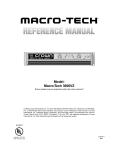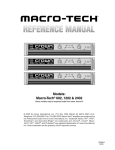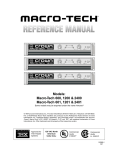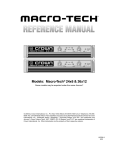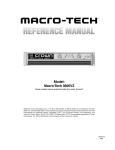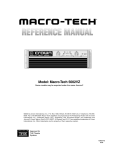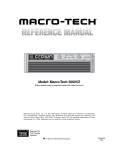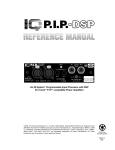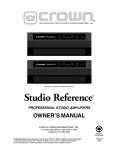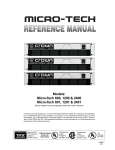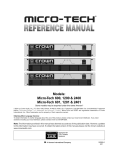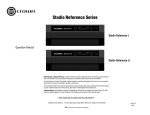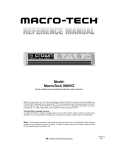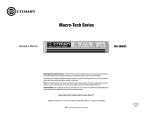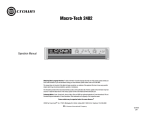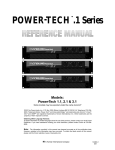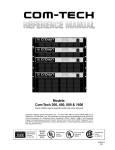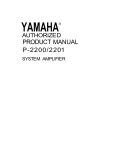Download Crown IQ-PIP-SMT Technical information
Transcript
LEVEL 12 15 LEVEL 18 9 12 ODEP 21 15 18 9 21 3 27 ON 24 6 24 6 OFF SIGNAL / IOC 27 3 0 30 CH1 (2400) 0 (600) CH2 LEVEL 12 9 15 30 ENABLE LEVEL 18 12 ODEP 21 15 18 9 21 3 27 ON 24 6 24 6 OFF SIGNAL / IOC 27 3 0 30 CH1 (3600) (1200) CH2 0 30 ENABLE Models: Macro-Tech 24x6 & 36x12 Some models may be exported under the name Amcron.® © 1996 by Crown International, Inc., P.O. Box 1000, Elkhart, IN 46515-1000 U.S.A. Telephone: 219-294-8000. Fax: 219-294-8329. Macro-Tech amplifiers are produced by the Professional Audio Division of Crown International, Inc. Trademark Notice: SmartAmp™ and Grounded bridge™ are trademarks and Amcron,® Crown,® Macro-Tech,® IOC,® ODEP,® IQ System,® P.I.P.® and TEF ® are registered trademarks of Crown International, Inc. Other trademarks are the property of their respective owners. 100131-1 7/96 3 YEAR THREE YEAR FULL WARRANTY 3 YEAR WORLDWIDE NORTH AMERICA SUMMARY OF WARRANTY The Crown Audio Division of Crown International, Inc., 1718 West Mishawaka Road, Elkhart, Indiana 46517-4095 U.S.A. warrants to you, the ORIGINAL PURCHASER and ANY SUBSEQUENT OWNER of each NEW Crown1 product, for a period of three (3) years from the date of purchase by the original purchaser (the “warranty period”) that the new Crown product is free of defects in materials and workmanship, and we further warrant the new Crown product regardless of the reason for failure, except as excluded in this Crown Warranty. SUMMARY OF WARRANTY The Crown Audio Division of Crown International, Inc., 1718 West Mishawaka Road, Elkhart, Indiana 46517-4095 U.S.A. warrants to you, the ORIGINAL PURCHASER and ANY SUBSEQUENT OWNER of each NEW Crown product, for a period of three (3) years from the date of purchase by the original purchaser (the “warranty period”) that the new Crown product is free of defects in materials and workmanship. We further warrant the new Crown product regardless of the reason for failure, except as excluded in this Warranty. 1 Note: If your unit bears the name “Amcron,” please substitute it for the name “Crown” in this warranty. ITEMS EXCLUDED FROM THIS CROWN WARRANTY This Crown Warranty is in effect only for failure of a new Crown product which occurred within the Warranty Period. It does not cover any product which has been damaged because of any intentional misuse, accident, negligence, or loss which is covered under any of your insurance contracts. This Crown Warranty also does not extend to the new Crown product if the serial number has been defaced, altered, or removed. WHAT THE WARRANTOR WILL DO We will remedy any defect, regardless of the reason for failure (except as excluded), by repair, replacement, or refund. We may not elect refund unless you agree, or unless we are unable to provide replacement, and repair is not practical or cannot be timely made. If a refund is elected, then you must make the defective or malfunctioning product available to us free and clear of all liens or other encumbrances. The refund will be equal to the actual purchase price, not including interest, insurance, closing costs, and other finance charges less a reasonable depreciation on the product from the date of original purchase. Warranty work can only be performed at our authorized service centers. We will remedy the defect and ship the product from the service center within a reasonable time after receipt of the defective product at our authorized service center. All expenses in remedying the defect, including surface shipping costs to the nearest authorized service center, will be borne by us. (You must bear the expense of all taxes, duties and other customs fees when transporting the product.) HOW TO OBTAIN WARRANTY SERVICE You must notify us of your need for warranty service not later than ninety (90) days after expiration of the warranty period. All components must be shipped in a factory pack. Corrective action will be taken within a reasonable time of the date of receipt of the defective product by our authorized service center. If the repairs made by our authorized service center are not satisfactory, notify our authorized service center immediately. DISCLAIMER OF CONSEQUENTIAL AND INCIDENTAL DAMAGES YOU ARE NOT ENTITLED TO RECOVER FROM US ANY INCIDENTAL DAMAGES RESULTING FROM ANY DEFECT IN THE NEW CROWN PRODUCT. THIS INCLUDES ANY DAMAGE TO ANOTHER PRODUCT OR PRODUCTS RESULTING FROM SUCH A DEFECT. WARRANTY ALTERATIONS No person has the authority to enlarge, amend, or modify this Crown Warranty. This Crown Warranty is not extended by the length of time which you are deprived of the use of the new Crown product. Repairs and replacement parts provided under the terms of this Crown Warranty shall carry only the unexpired portion of this Crown Warranty. DESIGN CHANGES We reserve the right to change the design of any product from time to time without notice and with no obligation to make corresponding changes in products previously manufactured. ITEMS EXCLUDED FROM THIS CROWN WARRANTY This Crown Warranty is in effect only for failure of a new Crown product which occurred within the Warranty Period. It does not cover any product which has been damaged because of any intentional misuse, accident, negligence, or loss which is covered under any of your insurance contracts. This Crown Warranty also does not extend to the new Crown product if the serial number has been defaced, altered, or removed. WHAT THE WARRANTOR WILL DO We will remedy any defect, regardless of the reason for failure (except as excluded), by repair, replacement, or refund. We may not elect refund unless you agree, or unless we are unable to provide replacement, and repair is not practical or cannot be timely made. If a refund is elected, then you must make the defective or malfunctioning product available to us free and clear of all liens or other encumbrances. The refund will be equal to the actual purchase price, not including interest, insurance, closing costs, and other finance charges less a reasonable depreciation on the product from the date of original purchase. Warranty work can only be performed at our authorized service centers or at the factory. We will remedy the defect and ship the product from the service center or our factory within a reasonable time after receipt of the defective product at our authorized service center or our factory. All expenses in remedying the defect, including surface shipping costs in the United States, will be borne by us. (You must bear the expense of shipping the product between any foreign country and the port of entry in the United States and all taxes, duties, and other customs fees for such foreign shipments.) HOW TO OBTAIN WARRANTY SERVICE You must notify us of your need for warranty service not later than ninety (90) days after expiration of the warranty period. All components must be shipped in a factory pack, which, if needed, may be obtained from us free of charge. Corrective action will be taken within a reasonable time of the date of receipt of the defective product by us or our authorized service center. If the repairs made by us or our authorized service center are not satisfactory, notify us or our authorized service center immediately. DISCLAIMER OF CONSEQUENTIAL AND INCIDENTAL DAMAGES YOU ARE NOT ENTITLED TO RECOVER FROM US ANY INCIDENTAL DAMAGES RESULTING FROM ANY DEFECT IN THE NEW CROWN PRODUCT. THIS INCLUDES ANY DAMAGE TO ANOTHER PRODUCT OR PRODUCTS RESULTING FROM SUCH A DEFECT. SOME STATES DO NOT ALLOW THE EXCLUSION OR LIMITATIONS OF INCIDENTAL OR CONSEQUENTIAL DAMAGES, SO THE ABOVE LIMITATION OR EXCLUSION MAY NOT APPLY TO YOU. WARRANTY ALTERATIONS No person has the authority to enlarge, amend, or modify this Crown Warranty. This Crown Warranty is not extended by the length of time which you are deprived of the use of the new Crown product. Repairs and replacement parts provided under the terms of this Crown Warranty shall carry only the unexpired portion of this Crown Warranty. DESIGN CHANGES We reserve the right to change the design of any product from time to time without notice and with no obligation to make corresponding changes in products previously manufactured. LEGAL REMEDIES OF PURCHASER No action to enforce this Crown Warranty shall be commenced later than ninety (90) days after expiration of the warranty period. LEGAL REMEDIES OF PURCHASER THIS CROWN WARRANTY GIVES YOU SPECIFIC LEGAL RIGHTS, YOU MAY ALSO HAVE OTHER RIGHTS WHICH VARY FROM STATE TO STATE. No action to enforce this Crown Warranty shall be commenced later than ninety (90) days after expiration of the warranty period. THIS STATEMENT OF WARRANTY SUPERSEDES ANY OTHERS CONTAINED IN THIS MANUAL FOR CROWN PRODUCTS. THIS STATEMENT OF WARRANTY SUPERSEDES ANY OTHERS CONTAINED IN THIS MANUAL FOR CROWN PRODUCTS. Telephone: 219-294-8200. Facsimile: 219-294-8301 Telephone: 219-294-8200. Facsimile: 219-294-8301 9/90 9/90 The information furnished in this manual does not include all of the details of design, production, or variations of the equipment. Nor does it cover every possible situation which may arise during installation, operation or maintenance. If your unit bears the name “Amcron,” please substitute it for the name “Crown” in this manual. If you need special assistance beyond the scope of this manual, please contact our Technical Support Group. Crown Audio Division Technical Support Group Plant 2 SW, 1718 W. Mishawaka Rd., Elkhart, Indiana 46517 U.S.A. Phone: 800-342-6939 (North America, Puerto Rico and Virgin Islands) or 219-294-8200 Fax: 219-294-8301 Fax Back: 800-294-4094 (North America only) or 219-293-9200 Internet: http://www.crownintl.com CAUTION AVIS RISK OF ELECTRIC SHOCK DO NOT OPEN RISQUE DE CHOC ÉLECTRIQUE N’OUVREZ PAS TO PREVENT ELECTRIC SHOCK DO NOT REMOVE TOP OR BOTTOM COVERS. NO USER SERVICEABLE PARTS INSIDE. REFER SERVICING TO QUALIFIED SERVICE PERSONNEL. DISCONNECT POWER CORD BEFORE REMOVING REAR INPUT MODULE TO ACCESS GAIN SWITCH. À PRÉVENIR LE CHOC ÉLECTRIQUE N’ENLEVEZ PAS LES COUVERCLES. IL N’Y A PAS DES PARTIES SERVICEABLE À L’INTÉRIEUR. TOUS REPARATIONS DOIT ETRE FAIRE PAR PERSONNEL QUALIFIÉ SEULMENT. DÉBRANCHER LA BORNE AVANT D’OUVRIR LA MODULE EN ARRIÈRE. Magnetic Field WARNING TO REDUCE THE RISK OF ELECTRIC SHOCK, DO NOT EXPOSE THIS EQUIPMENT TO RAIN OR MOISTURE! The lightning bolt triangle is used to alert the user to the risk of electric shock. CAUTION! Do not locate sensitive high-gain equipment such as preamplifiers or tape decks directly above or below the unit. Because this amplifier has a high power density, it has a strong magnetic field which can induce hum into unshielded devices that are located nearby. The field is strongest just above and below the unit. If an equipment rack is used, we recommend locating the amplifier(s) in the bottom of the rack and the preamplifier or other sensitive equipment at the top. The exclamation point triangle is used to alert the user to important operating or maintenance instructions. Printed on recycled paper. Macro-Tech 24x6 & 36x12 Power Amplifiers CONTENTS 1 Welcome ............................................................................ 7 1.1 Unpacking ................................................................... 7 1.2 Features ...................................................................... 7 2 Facilities ............................................................................ 8 3 Installation ....................................................................... 10 3.1 Mounting ................................................................... 10 3.2 Cooling ...................................................................... 10 3.3 Wiring ........................................................................ 11 3.3.1 Input Connection ............................................. 12 3.3.2 Output Connection .......................................... 14 3.3.3 Additional Load Protection .............................. 16 3.4 AC Power Requirements ............................................ 16 4 Operation ......................................................................... 17 4.1 Precautions ............................................................... 17 4.2 Indicators .................................................................. 17 4.3 Protection Systems .................................................... 18 4.3.1 ODEP .............................................................. 18 4.3.2 Standby Mode ................................................ 19 4.3.3 Transformer Thermal Protection ...................... 19 4.3.4 Circuit Breakers ............................................... 19 4.4 Controls ..................................................................... 19 4.5 Filter Cleaning ............................................................ 20 5 Technical Information ..................................................... 21 5.1 Overview ................................................................... 21 5.2 VZ Power (Macro-Tech 36x12 only) ........................... 21 5.2.1 Background .................................................... 21 5.2.2 The VZ Supply ................................................. 22 5.3 Circuit Theory ............................................................ 22 6 Specifications ................................................................. 25 7 AC Power Draw & Heat Dissipation ................................ 29 8 Accessories .................................................................... 30 8.1 P.I.P. Modules ............................................................ 30 8.2 Level Control Security Kit ........................................... 32 9 Service ............................................................................. 33 9.1 Worldwide Service ..................................................... 33 9.2 North American Service ............................................. 33 9.2.1 Service at a North American Service Center ... 33 9.2.2 Factory Service ............................................... 33 Page 4 Macro-Tech 24x6 & 36x12 Power Amplifiers ILLUSTRATIONS 1.1 2.1 2.2 3.1 3.2 3.3 3.4 3.5 3.6 3.7 3.8 3.9 3.10 3.11 3.12 3.13 4.1 4.2 4.3 5.1 5.2 5.3 5.4 5.5 6.1 6.2 6.3 6.4 7.1 7.1 8.1 8.2 Macro-Tech 36x12 Amplifier ...................................................... 7 Front Facilities ........................................................................... 8 Rear Facilities ........................................................................... 9 Mounting Dimensions ............................................................. 10 Top View of a Rack-Mounted Unit ........................................... 10 Proper Air Flow in a Rack Cabinet ........................................... 10 Wiring (a Macro-Tech 36x12 is shown) .................................... 11 Unbalanced Input Wiring ........................................................ 12 Balanced Input Wiring ............................................................ 12 Balanced and Unbalanced Phone Plug Wiring ....................... 12 Subsonic Filter Capacitors ...................................................... 13 Unbalanced RFI Filters ........................................................... 13 Balanced RFI Filters ................................................................ 13 Wire Size Nomograph ............................................................. 14 Inductive Load (Transformer) Network .................................... 16 Loudspeaker Fuse Selector Nomograph ................................ 16 Indicators ................................................................................ 17 ODEP and Signal/IOC Indicator States ................................... 18 Input Sensitivity and Ground Lift Switches .............................. 20 A Typical Power Supply .......................................................... 21 Complex Musical Waveforms .................................................. 22 VZ Supply in Parallel Mode ..................................................... 22 VZ Supply in Series Mode ....................................................... 22 Circuit Block Diagram ............................................................. 24 Typical Frequency Response .................................................. 27 Typical Damping Factor .......................................................... 27 Typical Output Impedance ...................................................... 27 Typical Phase Response ......................................................... 28 Macro-Tech 24x6 Pwr Draw, Current Draw and Therm Dis ...... 28 Macro-Tech 36x12 Pwr Draw, Current Draw and Therm Dis .... 29 Installing a P.I.P. Module .......................................................... 30 Installing an MA-LOCK Level Control Shaft Lock .................... 32 Page 5 Macro-Tech 24x6 & 36x12 Power Amplifiers Page 6 Macro-Tech 24x6 & 36x12 Power Amplifiers LEVEL 12 9 15 LEVEL 18 12 ODEP 21 15 18 9 21 3 27 ON 24 6 24 6 OFF SIGNAL / IOC 27 3 0 30 CH1 (3600) (1200) CH2 0 30 ENABLE Fig. 1.1 Macro-Tech 36x12 Amplifier 1 Welcome Congratulations on your purchase of a Macro-Tech ® dual level professional power amplifier. Your amplifier has a separate high-power and medium-power channel, making it ideal for biamplified systems. The MacroTech 24x6 combines one channel of a Macro-Tech 2400 with one channel of a Macro-Tech 600. The Macro-Tech 36x12 combines one channel of a MacroTech 3600VZ with one channel of a Macro-Tech 1200. And because each model has a separate power supply for each channel, each channel can be treated as a separate power amplifier. As a member of the Macro-Tech family, your amplifier offers the added benefit of ODEP ® protection which keeps the show going long after other amps would thermal off and Programmable Input Processor (P.I.P.®) compatibility to accept custom input modules (see Section 8 for available input modules). This manual will help you successfully install and use your new amplifier. We strongly recommend you read all instructions, warnings and cautions contained within. Also for your protection, please send in your warranty registration card today and save your bill of sale because it is your official proof of purchase. 1.2 Features Here are some of the impressive features: ❏ Crown’s grounded bridge™ design delivers incredible voltage swings without using stressful output transistor configurations like conventional amplifiers. The results are lower distortion and superior reliability. ❏ Patented ODEP (Output Device Emulation Protection) circuitry compensates for overheating and overload to keep the amplifier working long after others would fail. ❏ IOC ® (Input/Output Comparator) circuitry immediately alerts of any distortion exceeding 0.05%, providing dynamic proof of distortion-free performance. ❏ P.I.P. connector accepts accessories that tailor the amplifier to suit specific applications. ❏ Very low harmonic and intermodulation distortion give the best dynamic transfer function in the industry. ❏ High damping factor provides superior control over low frequency drivers for a clean, accurate low end. ❏ Full protection against shorted outputs, open circuits, DC, mismatched loads, general overheating, high frequency overloads and internal faults. ❏ Extra rugged, extruded aluminum front panel with ODEP and Signal Presence/IOC indicators for each channel, as well as an Enable indicator. ❏ Macro-Tech 36x12: Articulated VZ power supply for Channel 1 (3600) provides the best power matching to your load. 1.1 Unpacking Please unpack and inspect your new amplifier for any damage that may have occurred during transit. If damage is found, notify the transportation company immediately. Only you, the consignee, may initiate a claim for shipping damage. Crown will be happy to cooperate fully as needed. Save the shipping carton as evidence of damage for the shipper’s inspection. Even if the unit arrived in perfect condition, as most do, save all packing materials so you will have them if you ever need to transport the unit. NEVER SHIP THE UNIT WITHOUT THE FACTORY PACK. ❏ Efficient heat sinks and forced air cooling prevent overheating and prolong component life. ❏ Balanced inputs with three-position sensitivity switch and adjustable front panel level controls. ❏ 5-way binding post outputs provide versatile connection. ❏ Mounts in a standard 19 inch (48.3 cm) equipment rack (units can also be stacked). ❏ Three year “No-Fault” full warranty completely protects your investment and guarantees its specifications. Page 7 Macro-Tech 24x6 & 36x12 Power Amplifiers LEVEL 12 15 9 LEVEL 18 12 ODEP 21 15 18 9 21 3 27 ON 24 6 24 6 OFF SIGNAL / IOC 27 3 30 0 A B CH1 (3600) C (1200) CH2 D D C 0 30 B ENABLE E F Fig. 2.1 Front Facilities 2 Facilities A. Dust Filter D. ODEP Indicators The dust filters remove large particles from the air at the air intake. Check the filters regularly to be sure they don’t become clogged. The filter elements can be easily removed for cleaning by gently pulling them away from the front panel. See Section 3.2 and 4.5. During normal operation of the ODEP (Output Device Emulation Protection) circuitry, these amber indicators glow brightly to show the presence of reserve thermaldynamic energy. They dim proportionally as energy reserves decrease. In the rare event that energy reserves are depleted, the indicators turn off and ODEP proportionally limits output drive so the amplifier can safely continue operating even under severe conditions. These indicators can also help identify more unusual operating conditions (see Section 4.2). B. Level Controls The level for each channel is set with these convenient controls mounted on the front panel. Each level control has 31 detents for precise adjustment (see Section 4.4). A security option is available to prevent tampering (see Section 8.2). C. Signal / IOC Indicators These green multifunction indicators show signal presence and distortion for each channel. As signal presence indicators, they flash synchronously with the output audio signals to show their presence. As IOC (Input/Output Comparator) indicators, they flash brightly with a 0.1 second hold delay if there is a difference of 0.05% or more between the input and output signal waveforms. This provides proof of distortion-free performance. Another IOC function is to indicate input overload. If an input signal is too large, the indicator for the affected channel flashes brightly with a 0.5 second hold delay to show clipping distortion. Page 8 E. Enable Indicator This indicator lights when the amplifier has been “enabled” or turned on and AC power is present (see Section 4.2). F. Enable Switch This push button is used to turn the amplifier on and off. When turned on, the output is muted for approximately four seconds to protect your system from startup transients. (This delay can be changed. Contact Crown’s Technical Support Group for details.) G. Power Cord An appropriate power cord is provided. 120 VAC, 60 Hz units have a 20-amp (12 AWG) line cord with a grounded NEMA 5-15P plug. See Section 7 for AC power usage. Macro-Tech 24x6 & 36x12 Power Amplifiers CH-2 FX CH-1 CLASS 1 OUTPUT WIRING REQUIRED. PRE PRE S E T R E 100 VAC / 17.5 A / 50-60 Hz 120 VAC / 16.5 A / 60 Hz SERIAL NUMBER INPUT INPUT 3 Programmable Input Processor (P.I.P.) GND 1 2 THIS AMPLIFIER IS EQUIPPED WITH SELECTABLE INPUT SENSITIVITY. REMOVE P.I.P. MODULE TO ACCESS SENSITIVITY SWITCH. ® INTERNATIONAL, INC. ELECTRONIC EQUIPMENT ELKHART, IN 46517 MADE IN U.S.A. PUSH R E SS PUSH SS S E T PUSH TO RESET CH-2 BALANCED INPUT WIRING 0000 000000 + – REG. U.S. PAT. OFF. 4,330,809 4,611,180 GND INPUTS CH-1 UNBALANCED INPUT WIRING + TIP TIP INPUT GROUND LIFT RING SLEEVE (1200) LIFT GND (3600) SLEEVE (AFFECTS PHONE INPUTS ONLY.) G H I J K L CH-2 OUTPUT (1200) CH-1 OUTPUTS (3600) CAUTION: TO PREVENT ELECTRIC SHOCK DO NOT REMOVE TOP OR BOTTOM COVERS. NO USER SERVICEABLE PARTS INSIDE. REFER SERVICING TO QUALIFIED SERVICE PERSONNEL. DISCONNECT POWER CORD BEFORE REMOVING REAR P.I.P. MODULE TO ACCESS GAIN SWITCH. ATTENTION: DÉBRANCHER AVANT D'OUVRIR. WARNING: TO REDUCE THE RISK OF FIRE OR ELECTRIC SHOCK DO NOT EXPOSE THIS EQUIPMENT TO RAIN OR MOISTURE. J L M M M Fig. 2.2 Rear Facilities H. Reset Switches The reset switches are used to reset the breakers that safeguard each power supply from overload. are installed (see Section 3.3.4). The phone jacks can also be used as “daisy chain” outputs to simplify connecting input signals to multiple amplifiers. I. P.I.P. Module K. Ground Lift Switch The standard P.I.P.-FX is included with your amplifier. It provides female XLR input connectors. A variety of other P.I.P. modules can be used in place of the P.I.P.-FX. They add additional features that customize the amplifier for different applications (see Section 8.1 for information on available P.I.P. modules). This switch isolates or “lifts” the phone jack signal grounds from the AC power ground. Activating the switch inserts an impedance between the sleeve of each phone jack and the unit’s AC ground to help prevent the hum that can result from a ground loop. ❑ Input Sensitivity Switch The three-position input sensitivity switch located inside the amplifier is accessed by removing the P.I.P. module (I). It is factory-set to 0.775 volts for rated 8 ohm output. It can also be set to 1.4 volts for rated output, or a voltage gain of 26 dB (see Section 4.4). J. Balanced Phone Jack Inputs Balanced ¼-inch phone jack input connectors are provided on the back panel of your amplifier. The phone jacks can be wired for either balanced (tip, ring and sleeve) or unbalanced (tip and sleeve) input signals. Because they are electrically in parallel with the P.I.P. input connectors, input signals should not be connected to the phone jacks when certain P.I.P. modules L. Balanced XLR Inputs The factory-installed P.I.P.-FX provides a three-pin female XLR connector for balanced input to each channel. The XLR inputs are connected in parallel with the amplifier’s phone jack inputs. Because the P.I.P.-FX does not have any active circuitry, its XLR connectors can also be used as “daisy chain” outputs to connect signals from phone jack inputs to multiple amplifiers (see Section 3.3.4). M. Output Jacks A pair of versatile 5-way binding posts is provided for the output of each channel. The 5-way binding posts accept banana plugs, spade lugs or bare wire. Note: Because of its higher output power, the Macro-Tech 36x12 has an additional set of binding posts. Page 9 Macro-Tech 24x6 & 36x12 Power Amplifiers 3 Installation 3.1 Mounting Macro-Tech amplifiers are designed for standard 19 inch (48.3 cm) rack mounting as well as “stack” mounting without a cabinet. In a rack cabinet, it is best to mount them directly on top of each other. This provides efficient air flow and the best support. Important: Due to the weight of the unit, it should be securely fastened at the back of the cabinet. LEVEL 12 15 LEVEL 18 12 9 21 3 27 ODEP 9 15 18 21 ON 24 6 24 6 OFF SIGNAL / IOC 0 30 CH1 (3600) (1200) CH2 3.5 in 8.9 cm 27 3 0 30 ENABLE 19 in 48.3 cm SIDE VIEW 16 in 40.6 cm 2.5 in 6.35 cm Fig. 3.1 Mounting Dimensions 3.2 Cooling NEVER block the amplifier’s side vents or front air intake. Allow at least 45 cubic feet (1.3 cubic meters) of air flow per minute. All empty spaces in the rack cabinet should be covered with blank panels to prevent improper air flow. The amplifier’s air flow should be augmented with a rack cooling system if its load is less than 4 ohms and the amplifier must operate at high output levels. See Section 7 for additional information on thermal dissipation. When mounting the amplifier in a rack cabinet, the side walls of the rack should be at least 2 inches (5 cm) away from the chassis as shown in Figure 3.2. Tip: An easy way to verify adequate cooling is to observe the ODEP indicators while the amplifier is operating under worst-case conditions. If the indicators dim, additional cooling is recommended. If your rack cabinet has a front door that could block air flow to the amplifier’s air intakes, you must provide adequate air flow with either a grill in the door or by pressurizing the air behind the door. Wire grilles are recommended over perforated panels because they tend to create less turbulence. A good choice for pressurizing the air behind a rack cabinet door is to mount a “squirrel cage” blower inside the rack (option 1 below). At the bottom of the rack, mount the blower so it blows outside air into the space between the door and the front of the amplifiers, pressurizing the “chimney” behind the door. This blower should not blow air into or take air out of the space behind the amplifiers. For racks without a door, you can evacuate the rack by mounting the blower at the top of the rack, so that air inside the cabinet blows out the back (option 2 below). AIR FLOW EQUIPMENT RACK (SIDE VIEW) IMPORTANT: Be sure the back of the amplifier is supported. AIR FLOW AIR FLOW AMPLIFIER (TOP VIEW) 2 in (5 cm) MIN. AIR FLOW RACK CABINET AIR FLOW Fig. 3.2 Top View of a Rack-Mounted Unit Page 10 FRONT OF RACK DOOR 17 in 43.2 cm 16 in 40.6 cm BLOWER (OPTION 2) BLOWER (OPTION 1) Fig. 3.3 Proper Air Flow in a Rack Cabinet If the air supply is unusually dusty, it may be necessary to pre-filter it using commercial furnace filters, etc., to prevent rapid loading of the unit’s own air filter. When needed, the unit’s filter can be cleaned with mild dish detergent and water (see Section 4.5). Macro-Tech 24x6 & 36x12 Power Amplifiers 3.3 Wiring This section describes the most common way to install the Macro-Tech 24x6 and 36x12. Each model is designed for biamplified systems and includes both a high-power and a medium-power channel. The input and output terminals are located on the back panel. Please use care when making connections, selecting signal sources and controlling the output level. The load you save may be your own! Crown assumes no liability for damaged loads resulting from careless amplifier use and/or deliberate overpowering. to two-channel operation. They do NOT offer mono operation. WARNING: Never strap the outputs together for Parallel-Mono operation! Never bridge the outputs for Bridge-Mono operation! Installation of the Macro-Tech 24x6 and 36x12 is very intuitive. The Channel 1 input feeds the Channel 1 output and the Channel 2 input feeds the Channel 2 output. Be sure to connect the output wiring as shown in Figure 3.4. Five-way binding posts are provided to facilitate easy connection of loudspeakers to each channel. Note: Because of its higher output power, Channel 1 of a Macro-Tech 36x12 has an additional set of binding posts. Observe correct loudspeaker polarity and be very careful not to short the outputs of one channel to the outputs of the other channel. CAUTION: It is always wise to remove power from the unit and turn the input level controls off while making or changing connections—especially if the load is a loudspeaker system. This will eliminate any chance of loud blasts or damage to the loudspeakers. Because each channel produces a different power level, the Macro-Tech 24x6 and 36x12 are dedicated + – CHANNEL 2 LOUDSPEAKERS Use Channel 1 for loads like low-frequency drivers (like woofers) that need more power. Use Channel 2 for loads like high-frequency drivers (like horns) that require less power. HORN(S) CHANNEL 1 + CHANNEL 2 – MIXER EXAMPLE: HIGH FREQUENCY INPUT CH-2 PRE + S E T PRE WOOFERS CH-1 R E CH-2 (1200) INPUTS PUSH R E SS PUSH S E T FX SS CHANNEL 1 LOUDSPEAKERS EXAMPLE: LOW FREQUENCY INPUT INPUT INPUT – CH-2 OUTPUT (1200) CH-1 OUTPUTS (3600) CH-1 (3600) Fig. 3.4 Wiring (a Macro-Tech 36x12 is shown) Page 11 Macro-Tech 24x6 & 36x12 Power Amplifiers 3.3.1 Input Connection Both the balanced XLR and phone jack inputs have a nominal impedance of 20 K ohms (10 K ohms with unbalanced wiring) and will accept the line-level output of most devices. Female XLR input connectors are provided on the standard P.I.P.-FX input module (other P.I.P. modules are described in Section 8.1). Correct input wiring will depend on two factors: (1) whether the input signals are balanced or unbalanced, and (2) whether the signal source floats or has a ground reference. Figures 3.7 and 3.8 show the recommended connection techniques for each type of signal source. – + Note: If two or more channels with the same input ground reference are driven from the same INPUT floating source, connect Floating only one shield to the source chassis. source Output 3 1 2 – + 2-wire line cord (or battery power) – + 3 The amplifier’s built-in ¼ inch input phone connectors can be wired similarly for balanced or unbalanced, floating or ground-referenced sources. The connectors Grounded source Output – + INPUT + – + 2-wire line cord (or battery power) 3 INPUT Grounded source Output 1 2 Shield is not connected at this end + 3-wire grounded line cord (or other ground connection) – + 3 Output 1 2 + 2-wire line cord (or battery power) – + 3 INPUT Grounded source Output 1 2 Input ground terminal not used + Single-conductor coax or twisted pair INPUT Shield connected to both negative (–) and ground input terminals Floating source – + Fig. 3.6 Balanced Input Wiring Twin-lead shielded cable Output 2 Shield not connected at this end 2 Shield connected to ground terminal Floating source 1 3-wire grounded line cord (or other ground connection) 3 1 INPUT have a standard tip-ring-sleeve (TRS) configuration: the tip is positive (+), the ring is negative (–) and the sleeve is ground (see Figure 3.7). Wiring for various sources follows the XLR wiring guidelines shown in Figures 3.5 and 3.6. The phone jacks should not be used as inputs when a P.I.P. module with active circuitry is installed. The phone jacks are in parallel with the output of the P.I.P. module, so an input signal connected to the phone jacks can feed backwards into the active circuitry of the P.I.P. and cause undesirable distortion. You can use the phone jacks for signal input with any of the following P.I.P. modules installed: P.I.P.-FX, P.I.P.-BB, P.I.P.-FMX, P.I.P.FXQ and P.I.P.-FPX. All other P.I.P. modules have active circuitry and should not be installed if you plan to connect input signals to the phone jacks. The phone jacks can always be used as “daisy chain” outputs to feed post-processed signals from the P.I.P. to the inputs of other amplifiers. + – BALANCED SHIELD + 3-wire grounded line cord (or other ground connection) UNBALANCED SHIELD Fig. 3.5 Unbalanced Input Wiring Fig. 3.7 Balanced and Unbalanced Phone Plug Wiring Page 12 Macro-Tech 24x6 & 36x12 Power Amplifiers SOLVING INPUT PROBLEMS Sometimes large subsonic (subaudible) frequencies are present in the input signal. These can damage loudspeakers by overloading or overheating them. To attenuate such frequencies, place a capacitor in series with the input signal line. The graph in Figure 3.8 shows some capacitor values and how they affect the frequency response. Use only low-leakage paper, mylar or tantalum capacitors. 910 Ω + A + .003 µf Balanced In – – 910 Ω 1.8 mH + B Balanced In + .015 µf – Balanced Out – 1.8 mH 2.5 mH + C dB Balanced In + .018 µf – Balanced Out – 2.5 mH 0 0.47 Film 1.8 mH –5 –10 Balanced Out + f 1µ .1 µf .05 µf .01 D µf Balanced In + .015 µf – –15 Balanced Out – 0.47 Film 1.8 mH 1 Hz 10 Hz 100 Hz 1 kHz 10 kHz Fig. 3.10 Balanced RFI Filters Frequency Fig. 3.8 Subsonic Filter Capacitors Tip: The P.I.P.-FX that came with your amplifier has plenty of room on its circuit board for input filters. Another problem to avoid is the presence of large levels of radio frequencies or RF in the input signal. Although high RF levels may not pose a threat to the amplifier, they can burn out tweeters or other loads that are sensitive to high frequencies. Extremely high RF levels can also cause your amplifier to prematurely activate its protection circuitry, resulting in inefficient operation. RF can be introduced into the signal by local radio stations and from the bias signal of many tape recorders. To prevent this from happening, place an appropriate low-pass filter on the input(s). Some examples of unbalanced wiring are shown below: A third problem to avoid is hum. The two most common sources of hum in an audio system are inductive coupling and ground loops. 1.8 K ohm Source .003 µf To Amp dB 0 GND 6 dB/octave A 3.9 mH R 600 ohm Source .015 µf To Amp A 12 dB/octave –10 B GND 5 mH R 600 ohm Source Input Wiring Tips 1. Use only shielded cable. The higher the density of the shield (the outer conductor), the better the cable. Spiral wrapped shield is not recommended. 2. When using unbalanced lines, keep the cables as short as possible. Avoid cable lengths greater than 10 feet (3 meters). C B .018 µf Inductive coupling can occur when input cables are subjected to a magnetic field from a power cord or power transformer. One way to prevent inductive coupling is to lace the input cables together along their length and route them as far away as possible from power transformers and power cords. The use of –20 To Amp GND C 4 kHz Note: A low source impedance (R) can be increased to 600 ohms with an appropriate resistor. 10 kHz 40 kHz 3. Do not run signal cables together with highlevel wiring such as loudspeaker wires or AC cords. (This lessens the chance of hum or noise being induced into the input cables.) 100 kHz Frequency Fig. 3.9 Unbalanced RFI Filters For balanced input wiring use one of the examples in Figure 3.10. Filters A, B and C correspond to the unbalanced filters above. Filter D also incorporates the subsonic filter described in Figure 3.8. 4. The amplifier should be off for at least 10 seconds before changing any connections. Remember, the amplifier can produce lethal output energy and can drive loudspeakers to levels which can cause permanent hearing damage. Crown is not liable for personal injury or damage incurred when a transducer or component is overdriven. Page 13 Macro-Tech 24x6 & 36x12 Power Amplifiers shielded pair cable is another effective way to reduce or eliminate hum resulting from inductive coupling. Ground loops often result when two or more devices are improperly grounded. This causes undesirable stray currents that may produce hum in the output. The best way to avoid ground loops is to ensure that all system devices are plugged into the same power strip. In addition, make sure that all cable shields are grounded at one end only. resistance increases. This is very important because the amplifier’s excellent damping factor can easily be negated by insufficient loudspeaker cables. Use the nomograph in Figure 3.11 and the procedure that follows to find the recommended wire gauge (AWG or American Wire Gauge) for your system. .0002 .0002 RS Source Resistance (Ohms) .0004 Input and output grounds are sometimes tied together for testing or metering. This can cause feedback oscillation from load current in the test loop. In some systems, even the AC power line may provide this feedback path. Proper grounding, input isolation and isolation of common AC devices in the system is good practice. .0006 .001 RL RS Damping Factor .002 20,000 .004 10,000 .006 .01 5,000 3.3.2 Output Connection Consider the power-handling capacity of your load before connecting it to the amplifier. Crown is not liable for damage incurred at any time due to a load being overpowered. The use of loudspeaker protection fuses is highly recommended (see Section 3.3.3). Also, please pay close attention to the Operating Precautions in Section 4.1. RL Load Resistance (Ohms) 40 .02 1,000 30 .06 200 100 .2 50 Use Good Connectors 20 10 5 2 10 5. Connectors with any tendency to short should never be used. 2 Page 14 2 0.6 5 1.5 10 3.1 20 50 100 6.1 15.3 30.5 200 61.0 500 152.5 1000 305.0 2000 610.0 5000 1525 Feet Meters 500 100 50 7 #20 10 5 10 6 4 40 #14 #10 #8 #6 .5 #4 #2 .1 .01 3 2 #16 1 .05 20 #18 #12 1 5 #28 #26 #24 #22 6 1.5 HOW TO DETERMINE APPROPRIATE WIRE GAUGE It is important to use loudspeaker cables with sufficient gauge (thickness) for the length being used. The resistance introduced by inadequate loudspeaker cables will reduce both the output power and the motion control of the loudspeakers. The latter problem occurs because the damping factor decreases as the cable 0.3 9 4 AWG (American Wire Gauge) 1000 1 .4 8 4. Connectors having low current-carrying capacity should not be used. Two Conductor Cable 20 1 3. Connectors that can be plugged into AC power receptacles should never be used. Ohms/1000 Feet (305 Meters) .1 .6 2. Do not use connectors that might accidentally tie two channels together when making or breaking connections (for example, a standard three-wire stereo phone plug). 8000 .04 5000 500 15 1. To prevent possible short circuits, do not expose the loudspeaker cable connectors. Copper Wire 2,000 Example Shown: Load Resistance = 8 ohms Desired Damping Factor = 500 Source Resistance = 0.016 ohms Cable Length = 10 feet (3.1 meters) Recommended Wire: #8 AWG or equivalent wire with 1.75 ohms or less resistance per 1000 feet (305 meters). 1 0.9 0.8 0.7 0.6 0.5 Fig. 3.11 Wire Size Nomograph #0 #00 #0000 Macro-Tech 24x6 & 36x12 Power Amplifiers 1. Note the load resistance of the loudspeakers connected to each channel of the amplifier. Mark this value on the Load Resistance line of the nomograph. 2. Select an acceptable damping factor and mark it on the Damping Factor line. Your amplifier can provide an excellent damping factor of 1,000 from 10 to 400 Hz in Stereo mode with an 8-ohm load. In contrast, typical damping factors are 50 or lower. Higher damping factors yield lower distortion and greater motion control over the loudspeakers. A common damping factor for commercial applications is between 50 and 100. Higher damping factors may be desirable for live sound, but long cable lengths often limit the highest damping factor that can be achieved practically. (Under these circumstances, Crown’s IQ System ® is often used so amplifiers can be monitored and controlled when they are located very near the loudspeakers.) In recording studios and home hi-fi, a damping factor of 500 or more is very desirable. 3. Draw a line through the two points with a pencil, and continue until it intersects the Source Resistance line. 4. On the 2-Cond. Cable line, mark the length of the cable run. 5. Draw a pencil line from the mark on the Source Resistance line through the mark on the 2Cond. Cable line, and on to intersect the Annealed Copper Wire line. 6. The required wire gauge for the selected wire length and damping factor is the value on the Annealed Copper Wire line. Note: Wire size increases as the AWG value becomes smaller. 7. If the size of the cable exceeds what you want to use, (1) find a way to use shorter cables, like using the IQ System, (2) settle for a lower damping factor, or (3) use more than one cable for each line. Options 1 and 2 will require the substitution of new values for cable length or damping factor in the nomograph. For option 3, estimate the effective wire gauge by subtracting 3 from the apparent wire gauge every time the number of conductors of equal gauge is doubled. So, if #10 wire is too large, two #13 wires can be substituted, or four #16 wires can be used for the same effect. SOLVING OUTPUT PROBLEMS Sometimes high frequency oscillations occur that can cause your amplifier to prematurely activate its protection circuitry which can result in inefficient operation. The effects of this problem are similar to the effects of the RF interference described in Section 3.3.1. To prevent high frequency oscillations from occurring: 1. Lace the loudspeaker conductors together. (Do NOT lace cables together from different amplifiers.) This minimizes the chance of them acting like an antenna to transmit or receive high frequencies that can cause oscillation. 2. Avoid using shielded loudspeaker cable. 3. Avoid long cable runs where the loudspeaker cables from different amplifiers share a common cable tray or jacket. 4. Never connect the amplifier’s input and output grounds together. 5. Never tie the outputs of multiple amplifiers together. 6. Keep loudspeaker cables separated from input cables. 7. Install a low-pass filter on each input line (similar to the RF filters described in Section 3.3.1). 8. Install the input wiring according to the instructions in Section 3.3.1. Another problem to avoid is the presence of large subsonic currents when primarily inductive loads are used. Examples of inductive loads are 70-volt step-up transformers and electrostatic loudspeakers. Inductive loads can appear as a “short” at low frequencies, causing the amplifier to produce large low frequency currents and unnecessarily activate its protection circuitry. Always take the precaution of installing a high-pass filter at the amplifier inputs when a predominantly inductive load is used. A three-pole (18 dB per octave) filter with a –3 dB frequency of 50 Hz is recommended. (Depending on your application, it might be desirable to use a filter with more than a –3 dB frequency.) Such a filter should eliminate the subsonic frequency problems mentioned in Section 3.3.1. Another way to prevent the amplifier from activating its protection systems early and also protect the inductive load from large low-frequency currents is to connect a 590 to 708 µF nonpolarized capacitor and a 4 ohm, 20 watt resistor at the output of the amplifier and in series with the positive (+) lead of the transformer. This is depicted in Figure 3.12 on the next page. Page 15 Macro-Tech 24x6 & 36x12 Power Amplifiers Note: The components shown in Figure 3.12 are commonly available from most electronic supply stores. 4-ohm, 20-watt Resistor + + 590 to 708 µf Capacitor 120 VAC, N.P. From Amplifier Output Inductive Load Typical fuses help prevent damage due to prolonged overload, but provide essentially no protection against damage from large transients. To minimize this problem, use high-speed instrument fuses such as the Littlefuse 361000 series. If the loudspeaker is only susceptible to damage caused by prolonged overload (such as overheating), use a fuse or circuit breaker having the same slow thermal response as the loudspeaker itself (such as a slow-blow fuse). – – Fig. 3.12 Inductive Load (Transformer) Network 3.3.3 Additional Load Protection Because the amplifier generates enormous power, it may be desirable to protect loudspeakers (or other sensitive loads) from damage due to excessive power. A common way to do this is to put a fuse in series with the load. This may be accomplished by using a single fuse to protect all drivers connected to an output, or each driver may be fused individually. The nomograph in Figure 3.13 shows fuse size versus loudspeaker peak power rating. It can be used to determine what size fuse to use. 1.0 1.2 1.4 1.6 20 2 3000 15 2000 2.5 10 1500 8 3 1000 800 6 600 5 5 300 3 200 6 7 Example: Impedance = 8 ohms. Peak Power = 75 W 150 2 100 80 1.5 60 8 9 Answer: Fuse = 1.5 A 1 40 .8 10 30 .6 12 20 .5 15 25 30 .3 .2 .15 LOUDSPEAKER RATING 20 .4 FUSE (amps) 16 LOUDSPEAKER IMPEDANCE (ohms) 14 (Typically 4 times the continuous average power) 400 4 10 8 6 4 3 PEAK MUSIC POWER (watts) 4 2 .1 .08 1.5 1 40 Fig. 3.13 Loudspeaker Fuse Selector Nomograph Page 16 3.4 AC Power Requirements All Macro-Tech amplifiers are shipped with an appropriate line cord. When possible, use a power receptacle on a dedicated circuit and always make sure that it can supply the correct voltage and current. We do not recommend operating your amplifier on voltages greater than 10% above or below the unit’s rated voltage. For example, if your amplifier is rated for 120 VAC, the line voltage should not exceed 132 VAC. See Section 7 for power requirements under a variety of conditions. All specifications in this manual were measured using 120 VAC, 60 Hz power, unless otherwise noted. Specifications were derived using a voltage that is accurate to within 0.5% with THD less than 1.0% under all testing conditions. Performance variations can occur at other AC voltages and frequencies. In addition, line regulation problems directly affect the output power from the amplifier. Macro-Tech 24x6 & 36x12 Power Amplifiers 4 Operation LEVEL 12 9 4.1 Precautions 1. WARNING: Never strap the outputs together for Parallel-Mono operation! Never bridge the outputs for Bridge-Mono operation! The Macro-Tech 24x6 and 36x12 cannot be used in any mono mode. 2. Turn off the amplifier and unplug it from the AC mains before removing a P.I.P. card. 2. Use care when making connections, selecting signal sources and controlling the output level. The load you save may be your own. 3. Do not short the ground lead of an output cable to the input signal ground. This may form a ground loop and cause oscillations. 4. Operate the amplifier from AC mains of not more than 10% variation above or below the selected line voltage and only the specified line frequency. 5. Never connect the output to a power supply output, battery or power main. Such connections may result in electrical shock. 6. Tampering with the circuitry by unqualified personnel or unauthorized circuit changes invalidates the warranty. Remember: Crown is not liable for any damage resulting from overdriving other components in your system. 4.2 Indicators The front panel has several helpful indicator LEDs. The amber Enable indicator is provided to show the amplifier has been turned on (or enabled) and that its low voltage power supply and forced-air cooling system are working. It does not indicate the status of the high voltage supplies. For example, the Enable indicator will remain lit during unusual conditions that would cause the amplifier’s protection systems to put a highvoltage supply in “standby” mode (see Section 4.3). The amber ODEP indicators confirm the normal operation of Crown’s patented Output Device Emulation Protection circuitry. During normal operation, they glow brightly to show the presence of reserve thermal-dynamic energy. They dim proportionally as the energy reserve decreases. In the rare event that there is no reserve, the indicators turn off and ODEP proportion- LEVEL 18 12 ODEP 21 15 18 9 21 3 27 ON 24 6 24 6 OFF SIGNAL / IOC 27 3 Macro-Tech amplifiers are protected from internal and external faults, but you should take the following precautions for optimum performance and safety: 15 0 30 CH1 (3600) (1200) CH2 0 30 ENABLE Fig. 4.1 Indicators ally limits the drive level of the output stages so the amplifier can continue safe operation even when conditions are severe. (For a more detailed description of ODEP, see Section 4.3.1.) The ODEP indicator for the affected channel will turn off if a high-voltage power supply is put in “standby” mode, a high-voltage power supply fuse (or breaker) blows, or a transformer activates its thermal protection circuitry (see Section 4.3.2). Both ODEP indicators turn off if the amplifier loses AC power, the power switch is turned off or the low-voltage power supply fuse blows. The green Signal/IOC indicators show signal presence, distortion and input overload. As signal presence indicators, they flash with normal intensity in sync with the output audio signals. As IOC (Input/Output Comparator) indicators, they flash brightly if there is any difference between the input and output signal waveforms greater than 0.05%. Because transient distortion happens quickly, a 0.1 second “hold delay” keeps the indicators on long enough to be easily noticed. The IOC function provides proof of distortion-free performance. As input overload indicators, they flash brightly with a 0.5 second hold delay to show that an input signal is too large and must be clipped at the input. Under abnormal conditions where one of the amplifier’s high-voltage power supplies is temporarily put in standby mode, the Signal/IOC indicators will stay on with full brightness. They will resume normal operation when the amplifier is no longer in standby mode. The table in Figure 4.2 shows the possible states for the ODEP and Signal/IOC indicators. It also describes the conditions that may be associated with the different indicator states. The Enable indicator will be off with the first indicator state, “There is no power to the amplifier.” All other conditions in the table will occur with the Enable indicator turned on. It is important to note the possible states of the indicators in the rare event that you experience a problem. This can greatly aid in determining the source of problems. Please contact your local Crown representative or our Technical Support Group for further assistance. Page 17 Macro-Tech 24x6 & 36x12 Power Amplifiers Indicator Status ODEP OFF SIGNAL / IOC OFF ODEP SIGNAL / IOC ODEP SIGNAL / IOC ODEP SIGNAL / IOC ODEP SIGNAL / IOC ON Amplifier Condition There is no power to the amplifier and all indicators are off, including the Enable light. Possible reasons: (1) The amplifier Enable switch is off. (2) The amplifier is not plugged into the power receptacle. (3) The AC circuit breaker has been tripped. (4) The amplifier’s low-voltage power supply fuse has blown. Normal operation for a channel with NO audio output. Possible reasons: (1) There is no input signal. (2) The input signal level is very low. (3) The channel’s level control is turned down. OFF ON Normal ON Normal operation for a channel with audio output. The ODEP indicator will remain at full intensity to show that there is reserve thermodynamic energy, and the Signal/IOC indicator will flash with normal intensity to show that the channel has audio output. The channel’s output is exceeding 0.05% distortion. The input signal level is too high and IOC is reporting either an input overload or output clipping. Bright OFF Bright The amplifier channel is in standby mode. Possible reasons: (1) A P.I.P. module like an IQ–P.I.P.–SMT has turned off the channel’s high voltage power supply. (2) The amplifier has just been turned on and is still in the four second turn-on delay. (3) The DC/low-frequency protection circuitry has been activated. (4) The fault protection circuitry has been activated. (5) The transformer thermal protection circuitry has been activated. OR A channel’s breaker has tripped. Transformer overload can cause a channel’s circuit breaker to trip. OR ODEP limiting has been activated. Possible reasons: (1) The amplifier’s air filters are blocked and need to be cleaned. (2) There is insufficient cooling because of inadequate air flow or air that is too hot. (3) The load impedance for the channel is too low because the output is shorted or the channel is driving too many loudspeakers. (4) The amplifier channel is continuously being driven to very high output levels. ODEP SIGNAL / IOC OFF Normal ODEP limiting is about to begin. Possible reasons: (1) The amplifier’s air filters are blocked and need to be cleaned. (2) There is insufficient cooling because of inadequate air flow or air that is too hot. (3) The load impedance for the channel is too low because the output is shorted or the channel is driving too many loudspeakers. (4) The amplifier channel is continuously being driven to very high output levels. Fig. 4.2 ODEP and Signal/IOC Indicator States 4.3 Protection Systems Macro-Tech amplifiers provide extensive protection and diagnostics capabilities. Protection systems include ODEP, “standby” mode, fuses (or breakers), and special thermal protection for the unit’s transformers. 4.3.1 ODEP Crown invented ODEP to solve two long-standing problems in amplifier design: to prevent amplifier shutdown during demanding operation and to increase the efficiency of the output circuitry. To do this, Crown established a rigorous program to measure the safe operating area (SOA) of each output transistor before installing it in an amplifier. Next, Crown designed intelligent circuitry to simulate the instantaneous operating conditions of those output transistors. Page 18 Its name describes what it does: Output Device Emulation Protection or ODEP. In addition to simulating the operating conditions of the output transistors, it also compares their operation to their known SOA. If it sees that more power is about to be asked of them than they are capable of delivering under the present conditions, ODEP immediately limits the drive level until it falls within the SOA. Limiting is proportional and kept to an absolute minimum—only what is required to prevent output transistor damage. This level of protection enables Crown to increase output efficiency to never-before-achieved levels while greatly increasing amplifier reliability. The on-board intelligence is monitored in two ways. First, the front panel ODEP indicators show whether the amplifier is functioning correctly or if ODEP is limit- Macro-Tech 24x6 & 36x12 Power Amplifiers ing the drive level. Second, ODEP data is fed to the back panel P.I.P. connector so advanced P.I.P. modules like the IQ–P.I.P.–SMT can use it to monitor and control the amplifier. With ODEP, the show keeps going because you get the maximum power with the maximum protection. 4.3.2 Standby Mode At the heart of the protection systems is the standby mode which removes power from the high-voltage supplies to protect the amplifier and connected loads. The standby mode can be identified using the indicator table in Figure 4.2. Standby mode can be activated in several situations. First, if dangerous subsonic frequencies or direct current (DC) is detected in the amplifier’s output, the unit will activate its DC/low-frequency protection circuitry and put the affected channels in standby. This protects the loads and prevent oscillations. The unit resumes normal operation as soon as the amplifier no longer detects dangerous low frequency or DC output. Although it is extremely unlikely that you will ever activate the amplifier’s DC/low-frequency protection system, improper source materials such as subsonic square waves or input overloads that result in excessively clipped input signals can activate this system. The amplifier’s fault protection system will put an amplifier channel in standby mode in rare situations where heavy common-mode current is detected in the channel’s output. The amplifier should never output heavy common-mode current unless its circuitry is damaged in some way, and putting a channel in standby mode helps to prevent further damage. The amplifier’s transformer thermal protection circuitry is activated in very unusual circumstances where the unit’s transformer temperature rises to unsafe levels. Under these abnormal conditions, the amplifier will put the channel of the affected transformer in standby mode. The amplifier will return to normal operation after the transformer cools to a safe temperature. (For more information on transformer thermal protection, refer to the following section.) 4.3.3 Transformer Thermal Protection All Macro-Tech amplifiers have transformer thermal protection. It protects the power supplies from damage under the rare conditions of transformer temperatures rising too high. A thermal switch embedded in each transformer removes power to the channel if there is excessive heat. The switch automatically resets when the transformer cools to a safe temperature. It is very unlikely that you will ever see a Macro-Tech amplifier activate transformer thermal protection as long as it is operated within rated conditions (see Section 6, Specifications). One reason is that ODEP keeps the amplifier working under very severe conditions. Even so, higher than rated output levels, excessively low impedance loads and unreasonably high input signals can generate more heat in the transformer than in the output devices. These conditions can overheat the transformer and activate its protection system. Macro-Tech amplifiers are designed to keep working under conditions where other amplifiers would fail. But even when its limits are exceeded, it will still protect itself—and your investment—from damage. 4.3.4 Circuit Breakers The power supplies are protected by circuit breakers. With rated loads and output levels, the circuit breakers should only shut down the amplifier in the rare instance of a catastrophic failure. Other protection systems like ODEP keep the amplifier operational under most other severe conditions. The circuit breakers can also shut down the amplifier in cases where extremely low-impedance loads and high output levels result in current draw that exceeds their rating. Again, this should only be possible when operating outside rated conditions, like when the amplifier is used to drive a 1-ohm load in Stereo mode, or when a signal overloads the input and is clipped severely. Macro-Tech amplifiers do not trip their breakers unless something is wrong. If a breaker trips, try to identify and correct the problem before resetting the breakers with the back panel Reset switches. If the problem persists, refer the unit to a qualified technician. 4.4 Controls The Enable switch is located on the front panel so you can easily turn the amplifier on or off. If you ever need to make any wiring or installation changes don’t forget to disconnect the power cord. The six steps listed next should be followed whenever you turn on the amplifier: 1. Turn down the level of your audio source. For example, set your master mixer’s volume to –∞. 2. Turn down the level controls of the amplifier (if they are not already down). 3. Turn on the Enable switch. The Enable indicator beside the switch should glow. During the four second mute delay which immediately follows, the Signal/IOC indicators will flash unpredictably and the ODEP LEDs will stay off. After the mute delay, the ODEP indicators should come on with full Page 19 Macro-Tech 24x6 & 36x12 Power Amplifiers brilliance and the Signal/IOC indicators should function normally (remain off if no signal is present; flash if a signal is present). SENSITIVITY SWITCH INSIDE ACCESS HOLE 4. After the mute delay, turn up the level of your audio source to the maximum desired level. 5. Turn up the level controls of the amplifier until the maximum desired sound level is achieved. 6. Turn down the level of your audio source to its normal range. 1.4 V 26 dB 0.77 V THIS AMPLIFIER IS EQUIPPED WITH SELECTABLE INPUT SENSITIVITY. REMOVE P.I.P. MODULE TO ACCESS SENSITIVITY SWITCH. BALANCED INPUT WIRING + – GND For ease of use, the Level controls are also located on the front panel. Each control has 31 detents for accurate repeatability. To prevent tampering with these controls, the Level Control Security Kit is available (see Section 8.2). The Input Sensitivity switch is located inside the P.I.P. compartment at the back of the amplifier. It is factoryset to 0.775 V for rated output into 8 ohms. If desired, it can be switched to 1.4 V for rated output into 8 ohms, or to a fixed voltage gain of 26 dB. At 26 dB voltage gain, the equivalent input sensitivity is: Macro-Tech 24x6: 3.1 and 2.2 V for Channel 1 and 2, respectively. Macro-Tech 36x12: 4.8 and 2.6 V for Channel 1 and 2, respectively. To change the input sensitivity: 1. Turn off the amplifier and disconnect its power cord from the AC mains power receptacle. 2. Remove the P.I.P. module (two screws). 3. Locate the sensitivity switch access hole inside the chassis opening as shown in Figure 4.3. It is located just above the phone jack inputs. 4. Set the switch to the desired position noted on the access hole label. (Move the switch toward the front panel to set the input sensitivity to 1.4 V for rated output power, move it to the middle position for a voltage gain of 26 dB, or move it toward the back panel to set the input sensitivity to 0.775 V.) 5. Replace the P.I.P. module and connect the power. The Ground Lift switch is located on the back panel and can provide isolation between the input signal grounds and the AC (chassis) ground. It affects only the phone jack inputs and has no affect on the P.I.P. module input connectors. Sliding the switch to the left isolates or “lifts” the grounds by placing an impedance between the sleeve of each input phone jack and the AC power ground. The noninverted and inverted signal lines for the P.I.P. module are connected in parallel with the corresponding lines of the phone jack inputs. The input signal Page 20 CH-2 INPUTS CH-1 UNBALANCED INPUT WIRING + TIP TIP INPUT GROUND LIFT RING SLEEVE LIFT (1200) (3600) GND SLEEVE (AFFECTS PHONE INPUTS ONLY.) GROUND LIFT SWITCH Fig. 4.3 Input Sensitivity and Ground Lift Switches grounds are not paralleled. Specifically, XLR pins 2 and 3 are connected in parallel with the tip and ring of the corresponding phone jack. However, pin 1 of the XLR is not connected in parallel with the sleeve of the phone jack. This makes it possible for a P.I.P. module to handle its own signal grounds independently. The Reset switches for the power supply circuit breakers are located on the back panel. The circuit breakers protect the power supplies against damage in cases where excessive current is being drawn from the AC mains. If a breaker trips, the IOC indicator for the affected channel(s) will turn on and the Enable indicator will remain on. To reset a breaker: 1. Turn off the Enable switch. 2. Press the breaker’s reset switch. 3. Turn the amplifier back on. Contact an authorized service center or Crown’s Technical Support Group if the problem persists. 4.5 Filter Cleaning Dust filters are provided on the air intakes to the cooling system (Figure 2.1). If this filter becomes clogged, the unit may not cool as efficiently as it should which might produce lower-than-normal output levels due to high heat diffuser temperature. To clean, remove each of the filter elements by gently pulling them away from the front panel. Clean with mild dishwashing detergent and warm water. Replacement filters may be ordered from the factory. Dust filters are not 100% efficient—long term this may require internal sink cleaning by a qualified technician. Internal cleaning information is available from our Technical Support Group. Macro-Tech 24x6 & 36x12 Power Amplifiers 5 Technical Information 5.1 Overview Your amplifier incorporates several new technological advancements including low stress output stages, realtime computer simulation of output transistor stress, an advanced heat diffuser embodiment and a modular system for signal input and processing. In addition, Macro-Tech 36x12 models also have an articulated VZ power supply in Channel 1. Custom protection circuitry limits temperature and current to safe levels while making the amplifier highly reliable and tolerant of faults. Unlike many lesser amplifiers, it can operate at its voltage and current limits without self-destructing. Real-time computer simulation is used to create an analogue of the junction temperature of the output transistors (hereafter referred to as the “output devices”). Current is limited only when the device temperature becomes excessive—and just by the minimum amount necessary. This patented approach is called ODEP or Output Device Emulation Protection. It maximizes the available output power and eliminates overheating, the major cause of output device failure. The amplifier is protected from all common hazards that plague high-power amplifiers, including shorted, open or mismatched loads; overloaded power supplies, excessive temperature, chain-destruction phenomena, input overload damage and high frequency blowups. The unit protects loudspeakers from DC in the input signal, turn-on and turn-off transients, and it detects and prevents unwanted DC in the output. The amplifier is also protected from internal faults. The patented four-quadrant topology used in the grounded output stages is called the grounded bridge. The grounded bridge topology takes full advantage of the power supplies delivering peak-to-peak voltages to the load that are twice the voltage seen by the output devices and twice the voltage generated by the power supplies. The grounded bridge topology is ground-referenced. Because the required current exceeds the limits of presently available components, composite output devices are constructed to function as gigantic NPN and PNP devices. Each output stage has two composite NPN devices and two composite PNP devices. The devices connected to the load are referred to as “high-side NPN and PNP” and the devices connected to ground are referred to as “low-side NPN and PNP.” Positive current is delivered to the load by increasing conductance simultaneously in the high-side NPN and low-side PNP stage, while decreasing conductance of the high-side PNP and low-side NPN in synchrony. A wide bandwidth, multiloop design is used for stateof-the-art compensation. This produces ideal behavior and results in ultra-low distortion values. Aluminum extrusions have been widely used for heatsinks in power amplifiers due to their low cost and reasonable performance. However, measured on a watts per pound or watts per volume basis, the extrusion technology doesn’t perform nearly as well as the thermal diffuser technology developed for Macro-Tech power amplifiers. Our thermal diffusers are fabricated from custom convoluted fin stock that provides an extremely high ratio of area to volume, or area to weight. All power devices are mounted directly to massive heat spreaders that are electrically alive. Electrifying the heat spreaders improves thermal performance by eliminating the insulating interface underneath the power devices. The chassis itself is used as part of the thermal circuit, and this maximizes utilization of the available resources. 5.2 VZ Power (Macro-Tech 36x12 only) VZ means Variable Impedance and is the name of Crown’s patented articulated power supply technology. This technology is what makes it possible to pack such tremendous power into Crown’s Macro-Tech 3600VZ and Macro-Tech 5000VZ amplifiers. The high-power channel of the Macro-Tech 36x12 uses this articulated power supply technology. 5.2.1 Background A power supply must be large enough to handle the maximum voltage and current needed by the amplifier to drive its maximum rated power into a specified load. To fulfill this requirement, conventional power supply dePOWER signs produce lots of TRANSISTOR + heat, are heavy, and take up precious real POWER SPEAKER estate. And it’s no seSUPPLY LOAD cret that heat is one of a power amplifiers – worst enemies. ConPOWER sider the circuit that TRANSISTOR follows in Figure 5.1. According to Ohm’s Law, as your power Fig. 5.1 A Typical Power Supply Page 21 Macro-Tech 24x6 & 36x12 Power Amplifiers supply becomes larger, the power transistors must dissipate more heat. Also, the lower the resistance of the power transistors, the more voltage you can deliver to the load. But when you lower the resistance of the transistors, you increase the current passing through them, and again increase the amount of heat they must dissipate. 5.2.2 The VZ Supply An articulated power supply like VZ avoids much of this problem by reducing the voltage applied to the transistors when less voltage is needed. Reducing the voltage reduces the heat, so the amplifier runs cooler and more power can be packed in safely. The VZ supply is divided into segments to better match the voltage and current requirements of the power transistors. Remember that audio signals like music are complex waveforms. Fig. 5.2 Complex Musical Waveforms For music the average level is always much less than the peak level. This means a power supply does not need to produce full voltage all of the time. VZ POWER SUPPLY POWER TRANSISTOR + SPEAKER LOAD VZ STAGE – + VZ STAGE – POWER TRANSISTOR The VZ supply is divided into two parts. When the voltage requirements are not high, it operates in a parallel mode to produce less voltage and more current. Fig. 5.3 VZ Supply in Parallel Mode The power transistors stay cooler and are not forced to needlessly dissipate heat. This is the normal operating mode of the VZ power supply. Page 22 VZ POWER SUPPLY + POWER TRANSISTOR VZ STAGE – SPEAKER LOAD POWER TRANSISTOR + VZ STAGE – Fig. 5.4 VZ Supply in Series Mode When the voltage requirements are high, VZ supplies switch to a series mode which produces higher voltage and less current. The amplified output signal never misses a beat and gets full voltage when it needs it—not when it doesn’t need it. Sensing circuitry watches the voltage of the signal to determine when to switch VZ modes. The switching circuitry is designed to prevent audible switching distortion and yield the highest possible dynamic transfer function—you hear only the music and not the amplifier. You get not only the maximum power with the maximum safety, but you also get the best power matching to your load. 5.3 Circuit Theory Each channel is powered by its own power transformer, T100 or T200. Both channels share TF-1, a low voltage transformer. The secondary outputs of each transformer are full-wave rectified by heavy duty bridge rectifiers and are filtered by large computer grade capacitors. A thermal switch embedded in each transformer protects them from overheating. The low voltage transformer TF-1 uses a separate fan motor winding. The TF-1 output is rectified by diodes D1-4, generates an unregulated 24 volts. Monolithic regulators U1-2 provide a regulated ±15 volts. For simplicity, the following discussion of the circuitry and operation will refer to one channel only. Please refer to the block diagram in Figure 5.5 and the schematics provided at the back of this manual. The input signal at the phone jack passes directly into the balanced gain stage (U104-C,D). Use of a P.I.P. module for input signal causes the input signal to pass through the P.I.P. and then to the balanced gain stage. The balanced gain stage (U104-C,D) causes balanced to single-ended conversion to take place using a difference amplifier. From there, gain can be controlled with a potentiometer. The error amp (U104-A) amplifies the difference between the output signal and the input Macro-Tech 24x6 & 36x12 Power Amplifiers signal from the gain pot, and drives the voltage translator stage. The voltage translator stage channels the signal to the Last Voltage Amplifiers (LVAs), depending on the signal polarity, from the error amp U104-A. The +LVA (Q105,Q125) and the –LVA (Q110,Q126), with their push-pull effect through the bias servo Q318, drive the fully complementary output stage. The bias servo Q318 is thermally coupled to the heat sink, and sets the quiescent bias current in the output stage to lower the distortion in the crossover region of the output signal. D301, D302, D303, and D304 are used to remove the charge on the unused portion of the output stage, depending on the polarity of the output signal. With the voltage swing provided by the LVAs, the signal then gains current amplification through the Darlington emitter-follower output stage. The bridge-balanced circuit (U104-B) receives a signal from the output of the amplifier, and differences it with the signal at the Vcc supply. The bridge-balanced circuit then develops a voltage to drive the bridge-balanced output stage. This results in the Vcc supply having exactly one half of the output voltage added to their quiescent voltage. D309, D310, D311 and a trimmer resistor set the quiescent current point for the bridge- balanced output stage. The protection mechanisms that affect the signal path are implemented to protect the amplifier under realworld conditions. These conditions are high instantaneous current, excessive temperature, and operation of the output devices outside safe conditions. Q107 and Q108 act as a conventional current limiter, sensing current in the output stage. The allowable current level is also adjusted as a function of voltage. When current at any one instant exceeds the design criteria, the limiters remove the drive from the LVAs, thus limiting current in the output stage to a safe level. To further protect the output stages, a specially developed ODEP (Output Device Emulation Protection) circuit is used. It produces an analog output proportional to the always changing safe operating area of the output transistors. This output controls the translator stage by removing any drive that exceeds the safe operating area of the output devices. Thermal sensor S100 gives the ODEP circuits vital information on the operating temperature of the heatsink on which the output devices are mounted. Should the amplifier fail in such a way that would cause DC across the output lead, the DC protection circuit senses this on the negative feedback loop and shuts down the power supply until the DC is removed. Page 23 Page 24 BALANCED INPUTS 1/4" PHONE XLR P.I.P. VARIABLE GAIN STAGE DISPLAY BALANCE INPUT STAGE ERROR AMP E TRANSLATOR ODEP TRANSLATOR A B C D CURRENT LIMIT C (ODEP) PNP HI OUTPUT STAGE NPN HI OUTPUT STAGE A (ODEP) + +Vcc –Vcc OUTPUT ONLY ONE CHANNEL SHOWN –Vcc LVA BIAS LVA +Vcc D (ODEP) PNP LOW OUTPUT STAGE NPN LOW OUTPUT STAGE B (ODEP) BIAS BRIDGE BALANCE –Vcc +Vcc DC/LF VZ MODE POWER CONTROL SUPPLY FAULT CONTROL E (ODEP) +Vcc –Vcc SUPPLY POWER Macro-Tech 24x6 & 36x12 Power Amplifiers Fig. 5.5 Circuit Block Diagram (Channel 1) Macro-Tech 24x6 & 36x12 Power Amplifiers 6 Specifications The following specifications apply to 120 VAC, 60 Hz units in stereo mode with 8 ohm loads and an input sensitivity of 26 dB unless otherwise specified. 120 VAC, 60 Hz Units: These units have a dedicated transformer for 120 VAC, 60 Hz power mains. International Units: These units have dedicated transformers for various AC mains voltages and line frequencies. Performance Frequency Response: ±0.1 dB from 20 Hz to 20 kHz at 1 watt (see Figure 6.1). Phase Response: ±10° from 10 Hz to 20 kHz at 1 watt (see Figure 6.4). Signal-to-Noise Ratio: (A-weighted) Greater than 105 dB below rated continuous average output from 20 Hz to 20 kHz. (No weighting) 100 dB below rated continuous average output from 20 Hz to 20 kHz. Harmonic Distortion (THD): Less than 0.05% at rated output from 20 Hz to 1 kHz, increasing linearly to less than 0.1% at 20 kHz. IM Distortion (IMD): Less than 0.05% from 10 milliwatts to full rated output. Damping Factor: Greater than 1,000 from 10 Hz to 400 Hz (see Figure 6.2). Slew Rate: Channel 1, greater than 30 volts per microsecond; Channel 2, greater than 13 volts per microsecond. Voltage Gain: 20:1 ±3% or 26 dB ±0.25 at +26 dB input sensitivity and the maximum level setting. The sensitivity varies by model and channel when the input sensitivity is set to 0.775 V as listed below: Macro-Tech 24x6 Channel 1 (2400): 83:1 ±12% or 38 dB ±0.5 dB. Macro-Tech 24x6 Channel 2 (600): 54:1 ±12% or 35 dB ±0.5 dB. Macro-Tech 36x12 Channel 1 (3600): 124.6:1 ±12% or 41.9 dB ±1.0 dB. Macro-Tech 36x12 Channel 2 (1200): 64:1 ±12% or 36 dB ±0.5 dB. 800 watts into 4 ohms. 520 watts into 8 ohms. Channel 2 (600): 400 watts into 2 ohms. 325 watts into 4 ohms. 225 watts into 8 ohms. Macro-Tech 36x12 Channel 1 (3600): 1800 watts into 2 ohms. 1565 watts into 4 ohms. 1120 watts into 8 ohms. Channel 2 (1200): 675 watts into 2 ohms. 480 watts into 4 ohms. 310 watts into 8 ohms. International Models Macro-Tech 24x6 Channel 1 (2400): 895 watts into 2 ohms. 745 watts into 4 ohms. 510 watts into 8 ohms. Channel 2 (600): 380 watts into 2 ohms. 335 watts into 4 ohms. 230 watts into 8 ohms. Macro-Tech 36x12 Channel 1 (3600): 1460 watts into 2 ohms. 1300 watts into 4 ohms. 965 watts into 8 ohms. Channel 2 (1200): 520 watts into 2 ohms. 420 watts into 4 ohms. 285 watts into 8 ohms. It is extremely important to have adequate AC power available. Power amplifiers cannot create energy—they must have the required voltage and current to deliver the undistorted rated wattages you expect. Load Impedance: Rated for 16, 8, 4, and 2 ohm use only. Safe with all types of loads, even reactive ones. Power Required AC Mains: All units require 90 watts or less at idle. See Section 7 for detailed information on AC power draw, current draw and thermal dissipation. Output Power: The following are guaranteed minimums for standard 1 kHz power at 1 kHz and 0.1% or less THD. Controls 120 VAC, 60 Hz Models Macro-Tech 24x6 Channel 1 (2400): 1050 watts into 2 ohms. Enable: A front panel pushbutton used to turn the amplifier on and off. Level: A 31-position detented rotary potentiometer for each channel located on the front panel used to control Page 25 Macro-Tech 24x6 & 36x12 Power Amplifiers the output level. Sensitivity: A three-position switch located inside the P.I.P. compartment used to select one of three input sensitivities for both channels: a sensitivity of 1.4 volts for full rated output, a fixed voltage gain of 26 dB or a sensitivity of 0.775 volts for full rated output (see Section 4.4). Ground Lift: A two-position back panel switch used to isolate the signal ground of the phone jacks from the chassis (AC) ground. Reset: A back panel switch for each channel used to reset the circuit breaker which protects each channel’s power supply. Indicators Enable: This amber indicator lights when the amplifier’s Enable switch is turned on and the low voltage power supply is operating. See Section 4.2. Signal/IOC: Each channel has a green front panel indicator that flashes to show amplifier output. If a channel’s output waveform differs from its input by 0.05% or more, the indicator flashes brightly to show distortion. This function provides proof of distortion-free performance. ODEP: Each channel has an amber front panel indicator that shows thermal-dynamic energy reserve. Normally, each ODEP indicator is lit to show available reserve energy. In the rare event that a channel has no reserve, its indicator will dim in proportion to ODEP limiting. An ODEP indicator may also turn off under other conditions (see Sections 4.2 and 4.3.1). Input/Output Input Connector: Two balanced ¼-inch phone jacks on the back panel and two balanced 3-pin female XLR connectors on the factory-installed P.I.P.-FX (see Section 8 for information on optional P.I.P. modules). Input Impedance: Nominally 20 K ohms, balanced. Nominally 10 K ohms, unbalanced. Input Sensitivity: Settings include 0.775 V and 1.4 V for rated output, or a fixed voltage gain of 26 dB (see Section 4.4). Output Signal: Unbalanced, two-channel. Output Connector: A pair of color-coded 5-way binding posts (for banana plugs, spade lugs or bare wire) for each Page 26 channel. Note: Channel 1 (3600) of Macro-Tech 36x12 models has two pair of binding posts. Output Impedance: Less than 10 milliohms in series with less than 2 microhenries (see Figure 6.3). DC Output Offset: (Shorted input) ±10 millivolts. Protection Macro-Tech amplifiers are protected against shorted, open or mismatched loads; overloaded power supplies; excessive temperature, chain destruction phenomena, input overload damage and high-frequency blowups. They also protect loudspeakers from input/output DC and turn-on/ turn-off transients. If unreasonable operating conditions occur, the patented ODEP circuitry will proportionally limit the drive level to protect the output transistor stages, particularly in the case of elevated temperature. Transformer overheating will result in a temporary shutdown of the affected channel; when it has cooled to a safe temperature, the transformer will automatically reset itself. Controlled slew-rate voltage amplifiers prevent RF burnouts. And input overload protection is provided by current-limiting resistance at the input. Refer to Section 4.3. Turn On: Four second turn-on delay with no dangerous transients. Contact Crown’s Technical Support Group to change the turn-on delay time. Construction Black coated steel chassis and aluminum front panel with Lexan overlay. Chassis utilizes specially designed flowthrough ventilation from front to side panels. Cooling: Internal heat diffusers with forced air cooling for rapid, uniform heat dissipation. Dimensions: 19 inch (48.3 cm) standard rack mount (EIA Std. RS-310-B), 3.5 inch (8.9 cm) height, 16 inch (40.6 cm) depth behind mounting surface, 2.5 inch (6.35 cm) in front of mounting surface. Approximate Weight: Center of gravity is approximately 6 inches (15 cm) behind the front mounting surface. Macro-Tech 24x6: 45 lbs, 4 oz. (20.5 kg). Shipping weight is 54 lbs, 11 oz. (24.8 kg). Macro-Tech 36x12: 50 lbs (22.7 kg). Shipping weight is 59 lbs. (26.8 kg). Macro-Tech 24x6 & 36x12 Power Amplifiers +2 +1 0 –1 –2 8 ohm 4 ohm –3 2 ohm 1 watt dB –4 –5 –6 –7 10 100 1K 10 K 100 K FREQUENCY (Hz) Fig. 6.1 Typical Frequency Response 1400 1200 1000 800 600 400 8 ohm 200 100 0 100 20 1K 10 K 20 K FREQUENCY (Hz) Fig. 6.2 Typical Damping Factor 504.0 126.8 6 dB MILLIOHMS 31.8 8.0 2.0 10 100 1K 10 K 100 K FREQUENCY (Hz) Fig. 6.3 Typical Output Impedance Page 27 Macro-Tech 24x6 & 36x12 Power Amplifiers TEF ® Measurement +45˚ 0˚ –45˚ 100 TECHRON TEF ® 1K 10 K 20 K FREQUENCY (Hz) Fig. 6.4 Typical Phase Response (Measured with TEF® Analyzer) Macro-Tech 24x6 L O A D 8 Ohm 4 Ohm 2 Ohm Current Draw (Amps) Thermal Dissipation kcal/hr AC Mains Power Draw (Watts) 100-120 V 230 V btu/hr 992 250 955 9.6 5.0 855 215 782 7.9 4.1 2.3 718 181 609 6.1 3.2 1.7 581 146 436 2.1 1.1 444 112 263 Current Draw (Amps) Thermal Dissipation Duty Cycle AC Mains Power Draw (Watts) 100-120 V 230 V btu/hr 50% 663 6.7 3.5 40% 548 5.5 2.9 30% 434 4.4 20% 319 10% 205 Current Draw (Amps) Thermal Dissipation kcal/hr AC Mains Power Draw (Watts) 100-120 V 230 V btu/hr kcal/hr 1342 338 1205 12.1 6.3 1641 414 1135 286 982 9.7 5.1 1374 346 3.2 928 234 759 7.6 4.0 1107 279 4.4 2.3 721 182 536 5.4 2.8 841 212 2.6 1.4 514 130 313 3.1 1.6 574 145 Fig. 7.1 Macro-Tech 24x6 Power Draw, Current Draw and Thermal Dissipation at Various Duty Cycles Page 28 Macro-Tech 24x6 & 36x12 Power Amplifiers 7 AC Power Draw and Thermal Dissipation This section provides detailed information about the amount of power and current drawn from the AC mains by the Macro-Tech 24x6 and 36x12 amplifiers and the amount of heat produced under various conditions. The calculations presented here are intended to provide a realistic and reliable depiction of the amplifiers. The following assumptions or approximations were made: • The amplifier’s available channels are loaded and full power is being delivered. • The amplifier efficiency at standard 1 kHz power is estimated to be 65%. • Quiescent power draw is 90 watts (an almost negligible amount for full-power calculations). • Quiescent thermal dissipation equals 105 btu/hr at 90 watts. • The estimated duty cycles take into account the typical crest factor for each type of source material. • Duty cycle of pink noise is 50%. • Duty cycle of highly compressed rock ‘n’ roll midrange is 40%. • Duty cycle of rock ‘n’ roll is 30%. • Duty cycle of background music is 20%. • Duty cycle of continuous speech is 10%. • Duty cycle of infrequent, short duration paging is 1%. Here are the equations used to calculate the data presented in Figures 7.1 and 7.2: AC Mains Power Draw (watts) Total output power will all x Duty channels driven (watts) Cycle = Amplifier Efficiency (.65) + Quiescent Power Draw (watts) The quiescent power draw of 90 watts is a maximum value and includes power drawn by the fan. The following equation converts power draw in watts to current draw in amperes: AC Mains Power Draw (watts) Current Draw = (amperes) AC Mains x Power Voltage Factor (.83) The power factor of 0.83 is needed to compensate for the difference in phase between the AC mains voltage and current. The following equation is used to calculate thermal dissipation: Thermal Dissipation = (btu/hr) ( Total output power with all x Duty x .35 channels driven (watts) Cycle Amplifier Efficiency (.65) + ) Quiescent Power Draw (watts) x 3.415 The constant 0.35 is inefficiency (1.00–0.65) and the factor 3.415 converts watts to btu/hr. Thermal dissipation in btu is divided by the constant 3.968 to get kcal. If you plan to measure output power under real-world conditions, the following equation may also be helpful: Thermal Dissipation = (btu/hr) ( Total measured output power x .35 from all channels (watts) Amplifier Efficiency (.65) + ) Quiescent Power Draw (watts) x 3.415 Macro-Tech 36x12 L O A D 8 Ohm 4 Ohm 2 Ohm Current Draw (Amps) Thermal Dissipation kcal/hr AC Mains Power Draw (Watts) 100-120 V 230 V btu/hr 1622 409 1663 16.7 8.7 1359 342 1348 13.5 7.1 3.9 1096 276 1034 10.4 5.3 2.8 833 210 719 3.1 1.6 570 144 405 Current Draw (Amps) Thermal Dissipation Duty Cycle AC Mains Power Draw (Watts) 100-120 V 230 V btu/hr 50% 1190 12.0 6.2 40% 970 9.7 5.1 30% 750 7.5 20% 530 10% 310 Current Draw (Amps) Thermal Dissipation kcal/hr AC Mains Power Draw (Watts) 100-120 V 230 V btu/hr kcal/hr 2188 551 1994 20.0 10.4 2583 651 1812 457 1613 16.2 8.5 2128 536 5.4 1436 362 1232 12.4 6.5 1673 422 7.2 3.4 1059 267 852 8.6 4.5 1218 307 4.1 2.1 683 172 471 4.7 2.5 762 192 Fig. 7.2 Macro-Tech 36x12 Power Draw, Current Draw and Thermal Dissipation at Various Duty Cycles Page 29 Macro-Tech 24x6 & 36x12 Power Amplifiers 8 Accessories FTE CH-2 INPUT + CH-1 INPUT – + – 8.1 P.I.P. Modules One advantage of Macro-Tech amplifiers is the ability to customize them using P.I.P. (Programmable Input Processor) and PIP2 modules. Macro-Tech amplifiers are equipped with an edge card connector inside the back panel P.I.P. compartment. The modules install easily: L BACK PANE ER OF AMPLIFI Programmable Input Processor (P.I.P.) P.I.P.–FTE uses balanced 1:1 transformers to isolate the amplifier from the input signal. It also includes 12 dB/octave RFI filters, 18 dB/octave high pass filters, and 6 dB/octave 3 kHz shelving networks for “constant-directivity” horn equalization. Screw terminal plugs are provided for input. P.I.P. LE MODU P.I.P.- MEM PUSH IN DSPI CROWN OUT BUS PUSH AUX 3 2 2 2 1 GND 3 GND Fig. 8.1 Installing a P.I.P. Module WARNING: Disconnect power to the amplifier when installing or removing a P.I.P. module. P.I.P.s carrying the PIP2 logo are configured to use one or more of the PIP2 enhanced features. These features are only available in a PIP2-compatible amplifier. Of course, the exact features used will depend upon the function of the PIP2 module. Here are some of the available P.I.P. and PIP2 modules: 3 1 OUT 2 IN C H - 2 AUDIO IN C H - 1 1 1 GND MEM#.### IQ–P.I.P.–MEM is PIP2-compatible and integrates the amplifier into Crown’s patented IQ System.® The IQ System provides computer control of 1 to 2000 amplifiers. For example, each amplifier channel can be monitored and controlled from a personal computer attached to an IQ System. A memory backup feature enables the IQ–P.I.P.–MEM to remember all configuration settings when the power is turned off. P.I.P.- SMT PUSH IN DSPI CROWN OUT BUS PUSH AUX 3 AMC 1 GND 3 GND PUSH Programmable Input Processor (P.I.P.) OUTPUT INPUT 3 GND 1 2 P.I.P.–AMCb unites many features of the P.I.P.-XOV and P.I.P.– CLP. It offers a variable 4th-order Linkwitz-Riley crossover and an IOC-driven, variable threshold compressor. In addition, it provides “constant-directivity” horn equalization and filter-assisted B6 vented box equalization. Biamping and triamping capabilities are provided via XLR connectors. EDCb 2 2 2 CH-2 C H - 2 AUDIO IN C H - 1 1 3 OUT 2 IN 1 1 GND SMT#.### IQ–P.I.P.–SMT is also PIP2-compatible and includes all the features of the IQ–P.I.P.–MEM plus SmartAmp™ capability. Once the unit has been configured by an IQ System, its SmartAmp capabilities enable it to function autonomously. We call this distributed intelligence.™ The SmartAmp features include a smooth output limiter for transparent loudspeaker protection, power supply gates for energy savings, ODEP conservation to protect output devices with precision input signal control, interrupt-driven reporting that lets you define error conditions, and configurable short circuit detection. CH-1 P.I.P.- DSP PUSH IN DSPI CROWN OUT BUS PUSH AUDIO OUT PUSH PUSH INPUT INPUT 3 Programmable Input Processor (P.I.P.) GND 1 2 CH-2 2 1 3 GND P.I.P.–EDCb combines a sophisticated error-driven compressor and smooth limiter with a maximum level setting and a subsonic filter for each channel. The compressors have adjustable attack and release times, and can be set to track each other. The compressors activate when a signal would otherwise clip the input, an IOC error occurs, or the output exceeds the selected threshold. The subsonic filters have corner frequencies of 24, 28, 32 and 36 Hz. Page 30 CH-1 TIP = RING = EXT. POWER INPUT C H - 2 AUDIO IN C H - 1 24 VDC / 400 mA DSP#.### IQ–P.I.P.–DSP is PIP2-compatible and provides digital signal processing capabilities to your amplifier, replacing the need for outboard signal processing equipment such as equalizers, crossover networks, signal delays and compressors. In addition, the IQ–P.I.P.–DSP includes all the SmartAmp features of the IQ–P.I.P.–SMT to give you access to standard IQ System amplifier functions and autonomous operation. Macro-Tech 24x6 & 36x12 Power Amplifiers CH-1 PUSH PUSH INPUT PUSH INPUT FMX 3 Programmable Input Processor (P.I.P.) GND 1 P.I.P.–CLP detects and prevents overload. Its compressor is driven by the amplifier’s built-in IOC error detection circuitry. Unlike typical signal-driven compressors, it only compresses the signal to prevent overload. It can deliver up to 13 dB of additional headroom without being noticeable. ISO CH-2 INPUT + + 3 CH-1 INPUTS GND 1 2 P.I.P.–FMX facilitates “daisy-chaining” balanced amplifier inputs. Female to male three-pin XLR connectors are used to passively bridge the inputs. PA – CH-1 INPUT – CH-2 INPUTS Programmable Input Processor (P.I.P.) 2 PUSH CH-2 CLP + – LINE – + MIC CH-2 MIC LEVEL CH-1 REMOTE MIC LEVEL – + – MIC CH-2 INPUTS + LINE CH-1 INPUTS —WARNING— THIS P.I.P. PROVIDES FULL ISOLATION FOR ISO-MODIFIED AMPLIFIERS ONLY! DO NOT CONNECT THE OUTPUT GROUND LUG TO THE INPUT COMMON OR CHASSIS GROUND. REFER TO P.I.P.–ISO OWNER’S MANUAL FOR FURTHER INFORMATION. Programmable Input Processor (P.I.P.) Programmable Input Processor (P.I.P.) P.I.P.–ISO is designed especially for 25 to 140 volt distributed systems where UL®-listed isolation is required. Installation requires minor amplifier modifications. With the P.I.P.–ISO installed, the amplifier outputs are safely isolated from the input terminals and the chassis. P.I.P.–PA adds a switchable balanced low-impedance mic input, a balanced line-level input and a compressor to each channel. Remote switching circuitry provides quick and quiet fades from mic to line and back. BEQ – ATNB + – ATTENUATION 16 18 20 22 24 28 60 10 8 14 12 7 6 5 4 3 2 1 ∞ dB 0 .5 + ATTENUATION 16 18 20 22 24 28 60 10 8 14 12 7 ∞ dB 0 + – IN + OUT CH-2 CH-1 .5 CH-1 INPUT (CH-1) TIE INPUT A (CH-2) RMT B RMT A OUT IN OUT MIC LINE PHAN MIC LINE PHAN (CH-2) INPUT B LEVEL (CH-1) PUSH P.I.P.–XOV is a versatile 18 dB/octave mono crossover/filter with biamping and triamping capabilities + – + – + – + – MIC LINE PHAN 2 MIC LINE PHAN 1 AUDIO BUS INPUT C LEVEL RING SLEEVE 3 GND CH-1 IN INPUT D TIP Programmable Input Processor INPUTS CH-2 RMT C – GND RPA RMT D XOV + P.I.P.–BEQ is a two-channel module providing equalization for BOSE® loudspeakers. For example, the P.I.P.–BEQ can be used in place of a BOSE 102 controller. Screw terminal plugs provide balanced connections. Each input channel has an output from the P.I.P. that can be independently configured for output with no processing, loudspeaker equalization or loudspeaker equalization with bass-cut. +10 V P.I.P.–ATNB uses balanced 1:1 transformers to isolate the amplifier from the input signal. It also includes 12 dB/octave RFI filters, variable 18 dB/octave high-pass filters, and 6 dB/ octave 3 kHz shelving networks for “constant-directivity” horn equalization. The module also includes a calibrated 21-step precision attenuator for each channel. Screw terminal plugs are provided for input. OUTPUTS – Programmable Input Processor (P.I.P.) Programmable Input Processor (P.I.P.) Programmable Input Processor (P.I.P.) + OUT 6 5 4 3 2 1 CH-2 INPUT + – IN – P.I.P.–RPA adds the features of a 4x2 mixer to your amplifier. Its four inputs accept mic- or line-level input. It offers priority switching (“voice-over”) of each input and remote level control with the RPA–RMT. Other features include bus inputs and outputs, adjustable input sensitivity, phantom power and RFI suppression. Input isolation transformers are optional. For more information on these or other P.I.P.s under development, contact your local dealer or Crown’s Technical Support Group. Page 31 Macro-Tech 24x6 & 36x12 Power Amplifiers 8.2 Level Control Security Kit The MA-LOCK security accessory can be used to secure your amplifier’s level controls in situations where the front panel controls are subject to tampering. The MA-LOCK security kit includes the necessary hard- ware to lock the two level controls on the front panel of any Macro-Tech amplifier. For more information, contact your local Crown dealer or Crown’s Technical Support Group. Fig. 8.2 Installing an MA-LOCK Level Control Shaft Lock Page 32 Macro-Tech 24x6 & 36x12 Power Amplifiers 9 Service This unit has very sophisticated circuitry which should only be serviced by a fully trained technician. This is one reason why each unit bears the following label: CAUTION: To prevent electric shock, do not remove covers. No user serviceable parts inside. Refer servicing to a qualified technician. sent “UPS ground.” (If the unit is under warranty, you may send it C.O.D. for the cost of freight via UPS ground.) The factory will return it via UPS ground. Please contact us if other arrangements are required. Always use the original factory pack to transport the unit. 9.1 Worldwide Service Service may be obtained from an authorized service center. (Contact your local Crown/Amcron representative or our office for a list of authorized service centers.) To obtain service, simply present the bill of sale as proof of purchase along with the defective unit to an authorized service center. They will handle the necessary paperwork and repair. Remember to transport your unit in the original factory pack. We will pay the surface shipping costs both ways for warranty service to the authorized service center nearest you after receiving copies of all shipping receipts. You must bear the expense of all taxes, duties, and customs fees when transporting the unit. 9.2 North American Service Service may be obtained in one of two ways: from an authorized service center or from the factory. You may choose either. It is important that you have your copy of the bill of sale as your proof of purchase. 9.2.1 Service at a North American Service Center This method usually saves the most time and effort. Simply present your bill of sale along with the defective unit to an authorized service center to obtain service. They will handle the necessary paperwork and repair. Remember to transport the unit in the original factory pack. A list of authorized service centers in your area can be obtained from our Technical Support Group. 9.2.2 Factory Service To obtain factory service, fill out the service information page that follows and send it along with your proof of purchase and the defective unit to the Crown factory. For warranty service, we will pay for ground shipping both ways in the United States after receiving copies of the shipping receipts. Shipments should be Factory Service Shipping Instructions: 1. When sending a Crown product to the factory for service, be sure to fill out the service information form that follows and enclose it inside your unit’s shipping pack. Do not send the service information form separately. 2. To ensure the safe transportation of your unit to the factory, ship it in an original factory packing container. If you don’t have one, call or write Crown’s Parts Department. With the exception of polyurethane or wooden crates, any other packing material will not be sufficient to withstand the stress of shipping. Do not use loose, small size packing materials. 3. Do not ship the unit in any kind of cabinet (wood or metal). Ignoring this warning may result in extensive damage to the unit and the cabinet. Accessories are not needed—do not send the instruction manual, cables and other hardware. If you have any questions, please call or write the Crown Technical Support Group. Crown Audio Division Technical Support / Factory Service Plant 2 SW, 1718 W. Mishawaka Rd., Elkhart, Indiana 46517 U.S.A. Telephone: 219-294-8200 800-342-6939 (North America, Puerto Rico, and Virgin Islands only) Facsimile: 219-294-8301 Fax Back: 219-293-9200 800-294-4094 (North America only) Internet: http://www.crownintl.com Page 33 Crown Factory Service Information Shipping Address: Crown International, Inc., Factory Service, Plant 2 SW, 1718 W. Mishawaka Rd., Elkhart, IN 46517 Phone: 1-800-342-6939 or 1-219-294-8200 Fax: 1-219-294-8301 Owner’s Name: _________________________________________________________________________ Shipping Address: ______________________________________________________________________ Phone Number: _____________________________ Fax Number: _____________________________ Model: ________________________ Serial Number: _____________ Purchase Date: ___________ NATURE OF PROBLEM (Be sure to describe the conditions that existed when the problem occurred and what attempts were made to correct it.) ______________________________________________________________________________ ______________________________________________________________________________ ______________________________________________________________________________ ______________________________________________________________________________ ______________________________________________________________________________ Detach and send with unit. ______________________________________________________________________________ ______________________________________________________________________________ ______________________________________________________________________________ ______________________________________________________________________________ ______________________________________________________________________________ ______________________________________________________________________________ ______________________________________________________________________________ ______________________________________________________________________________ ______________________________________________________________________________ ______________________________________________________________________________ Other equipment in your system: _________________________________________________________ ______________________________________________________________________________ ______________________________________________________________________________ ______________________________________________________________________________ ______________________________________________________________________________ ______________________________________________________________________________ ______________________________________________________________________________ If warranty has expired, payment will be: ❏ Cash/Check Card Number:___________________________ ❏ VISA ❏ MasterCard ❏ C.O.D. Exp. Date:_______ Signature:____________________________ ENCLOSE THIS PORTION WITH THE UNIT. DO NOT MAIL SEPARATELY.



































